Part of our 3 street art works series you should see today. Artists featured are Anthony Lemer, Seth and Sipros
Anthony Lemer
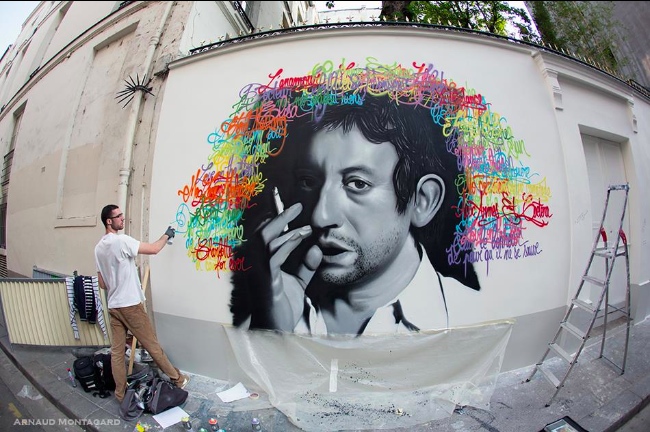
Seth

Sipros
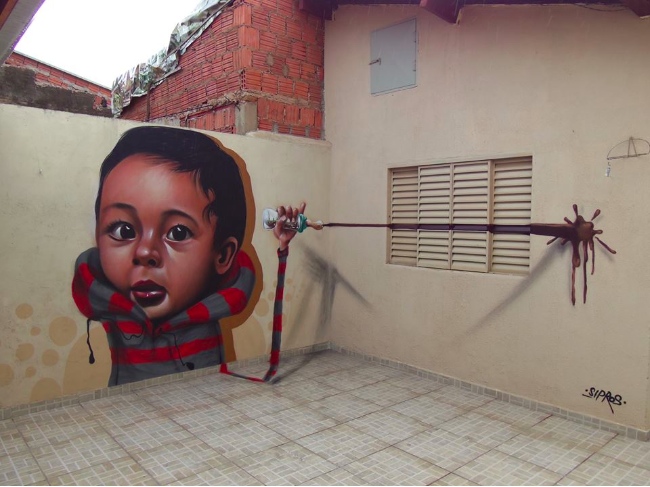
Related links
Anthony lemer’s website
Seth’s Flicker account
Sipros YouTube channel
Part of our 3 street art works series you should see today. Artists featured are Anthony Lemer, Seth and Sipros
Anthony Lemer

Seth

Sipros

Related links
Anthony lemer’s website
Seth’s Flicker account
Sipros YouTube channel
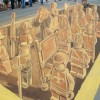 Take two thing a large number of us have manipulated once in their lives: LEGO and chalk. Take it further and create something too amazing for not writing something up about it. Dutchman Peter Westerink and a few other helping hands must have astonished a few by-passers with their 100m2 3D creation depicting a army of LEGO men Terracotta style.
Take two thing a large number of us have manipulated once in their lives: LEGO and chalk. Take it further and create something too amazing for not writing something up about it. Dutchman Peter Westerink and a few other helping hands must have astonished a few by-passers with their 100m2 3D creation depicting a army of LEGO men Terracotta style.
You will see below, pictures showing the steps these guys has to go through. Oh and did I mention that it took 6 full days to a crew of four artists (Leon Keer, who also came up with the design, Remko Van Schaik, Ruben Poncia and Peter Westerink) to get this leaped out if the concrete floor. No surprise that the Sarasota Chalk Festival in Florida was chosen, imagine doing that at Glastonbury festival where it is very likely to rain and wash out a pile of efforts.
A grid is first laid out using chalk, then painted over with white paint before being removed and a mammoth task begins: filling.
Peter and his crew (and many other artists) are part of Planet Streetpainting is a collaborative of international street painters
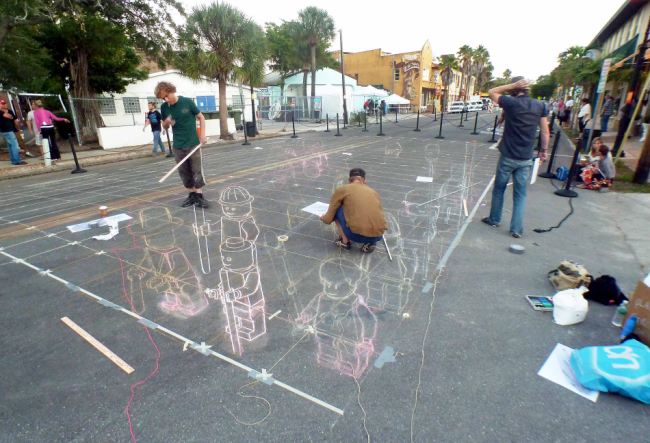
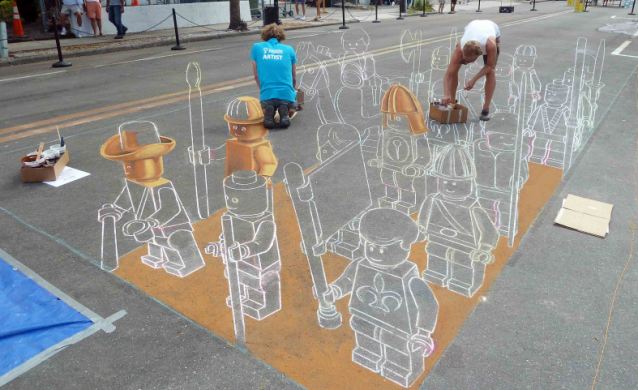
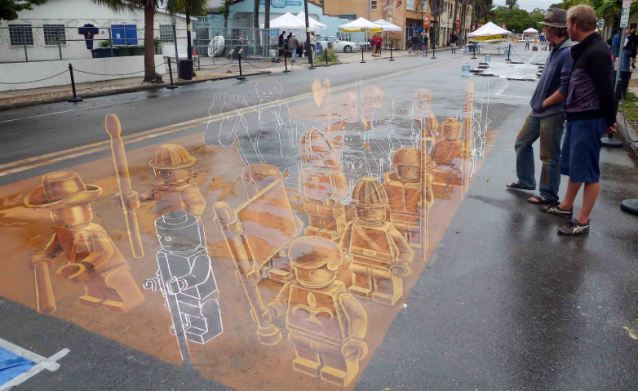
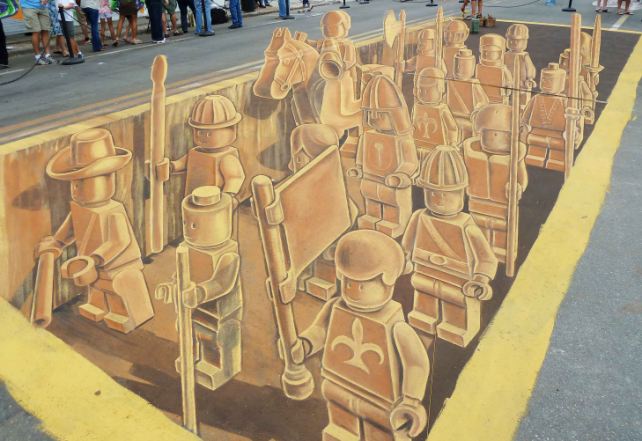
When having CDs is becoming so nineties, everything getsstored online in the cloud as they call it, Meet Sean Avery, a talented artist, thought twice about discarding his CDs and have found a way of turning them into amazing and crafted animal sculptures.
Sean Avery has created a series of sculptures—from bears to peregrine falcons and even the Loch Ness monster thanks to a clever use of the reflective splinters of his CDs. There is no much more to say to appreciate the time, effort and above all talent in his artwork.
Nick Gentry is another artist who recycles once very useful objects. His thing are floppy disks used to make up portraits.
The humming bird and the rat are just superb. Have a look below.
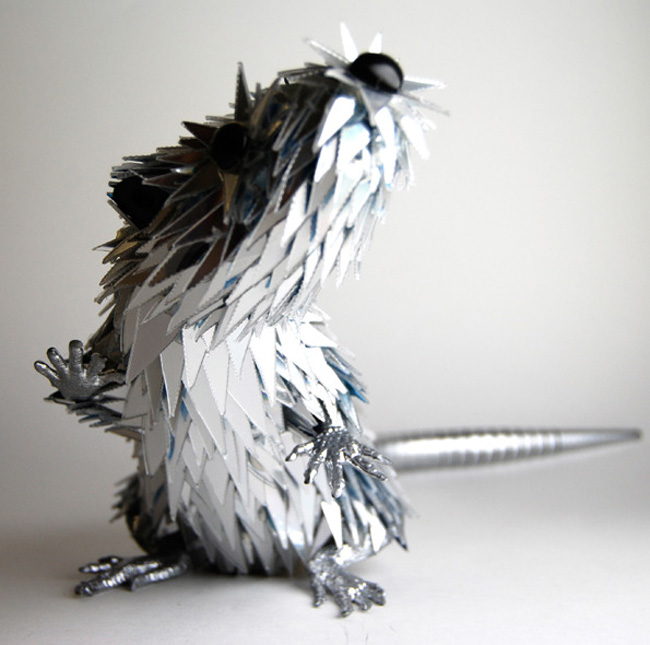
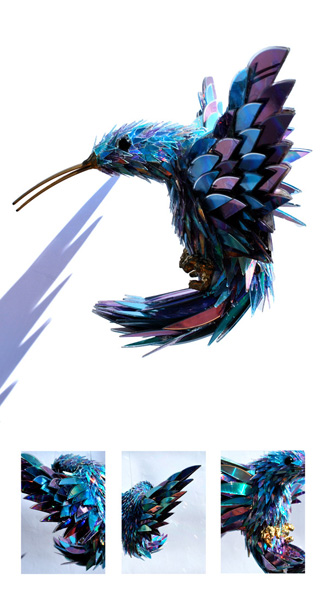
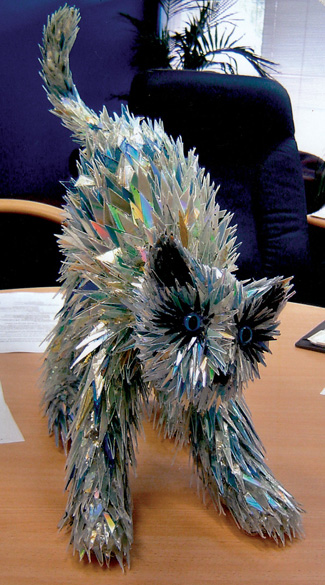
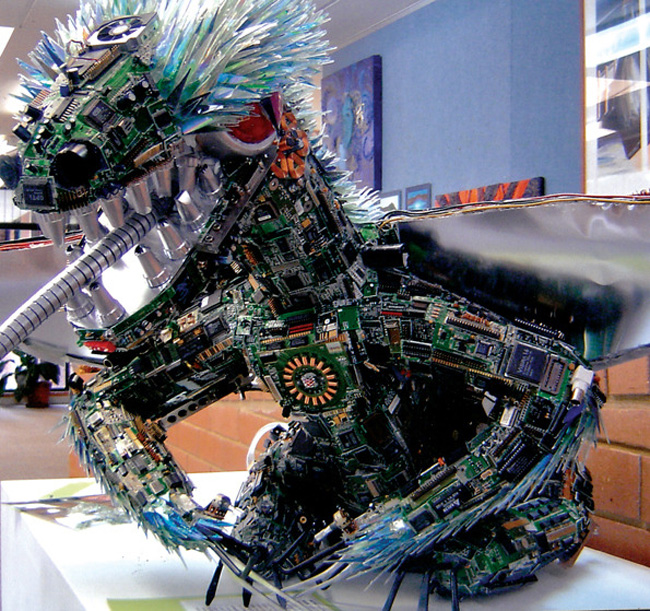
We have all seen these street artists colouring our pavements without could not put the finger on what the piece actually represent. It is because you are not looking at it at the right angle. We are talking here about anamorphic art which has recently flourished all over the world.
But some artists take this form of art to the next level making it methodical and magical. Located in the factory hosted by Sub Urb Art based in Torino (Italy), Medusa, figure from the Greek mythology, has taken the patience, attention to detail and talent of two artists, Ninja1 and Mach505.
The number of surfaces used is phenomenal and make the task daunting. It took 35 hours to paint the whole lot. It was achievable by projecting the outlines of an existing Medusa drawing on those surfaces and paint over them.
“Also, tracing a projection might seem simple, but at a distance of 20 meters the pixels are the size of your head, and hardly visible at all because of other lights, so you do need to check what you’re doing from the viewpoint every once in a while. “
Read the full interview on Modernet
From certain angles
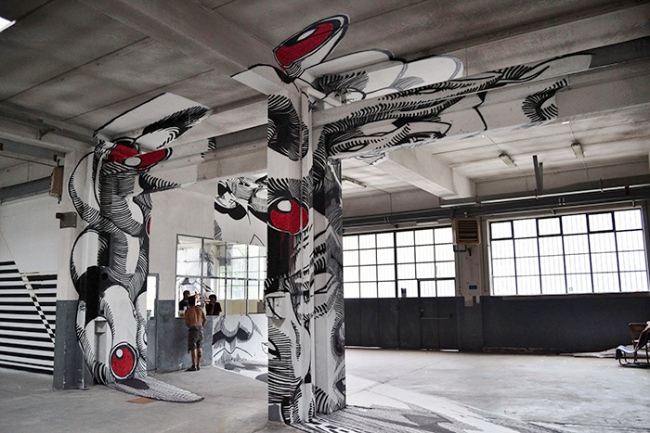
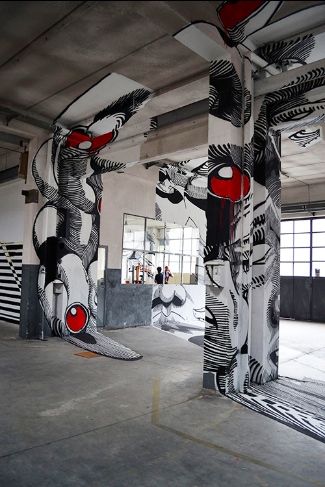
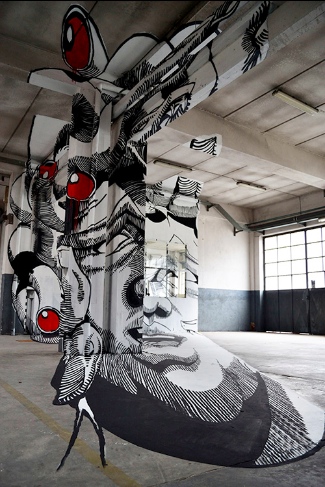
The end result
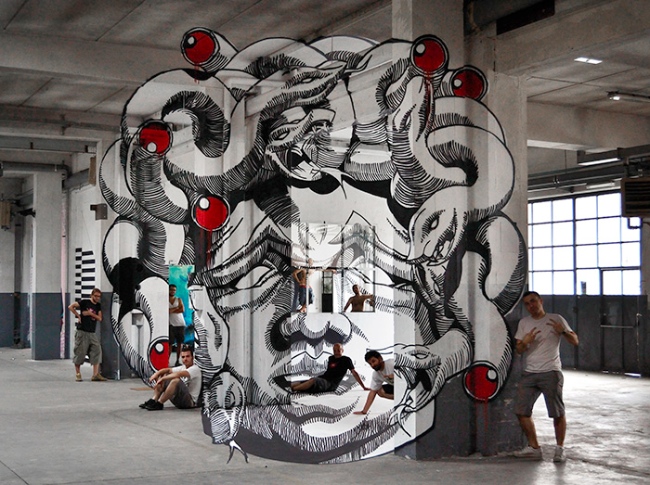
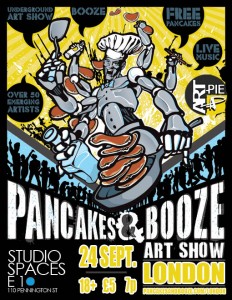
ART . PANCAKES . BOOZE . DJ . LIVE ART . EAST LONDON .
7pm till 2am
Pancake batter is sizzling, beer froth is flowing, and bare flesh is slathered in paint. Indie musicians and DJs break sound waves off the canvas-lined, graffiti-strewn walls, while revelers stuff their faces with endless amounts of free pancakes.
The Pancakes & Booze Art Show is an LA based artist movement that started in 2009 and has quickly spread to over 20+ cities throughout North America.
They currently organize some of the largest pop-up underground art showcases in the country, with the best local emerging artists, musicians, and performers each city has to offer.
Artists can submit their artwork by filling out our online submission form located below under “SUBMIT YOUR APPLICATION”
If accepted, there is a £10 per piece HANGING FEE to display your work.
There are NO COMMISSIONS ON SALES. You take 100% of what you sell. The £10 per piece goes towards the production costs of the event (i.e. venue rental, staff, building materials, etc.). PAYMENT (cash only) is not due until the day of installation.
There is a strict 1×1 meters MAX SIZE LIMIT for each piece you’d like to exhibit. This is due to the size of the wall panels we use to display your work. Sorry, but no work over 1×1 (meter) in size will be able to fit on the walls.
DROP OFF and INSTALLATION TIMES & DATES will be confirmed. In most cases, installation is on the day of the event between 12-5p. Once confirmed we’ll inform you of the correct time.
There is no DEADLINE for submitting artwork. We take art until we fill all the wall space available. P&B is an extremely popular show, so we recommend reserving space as soon as possible.
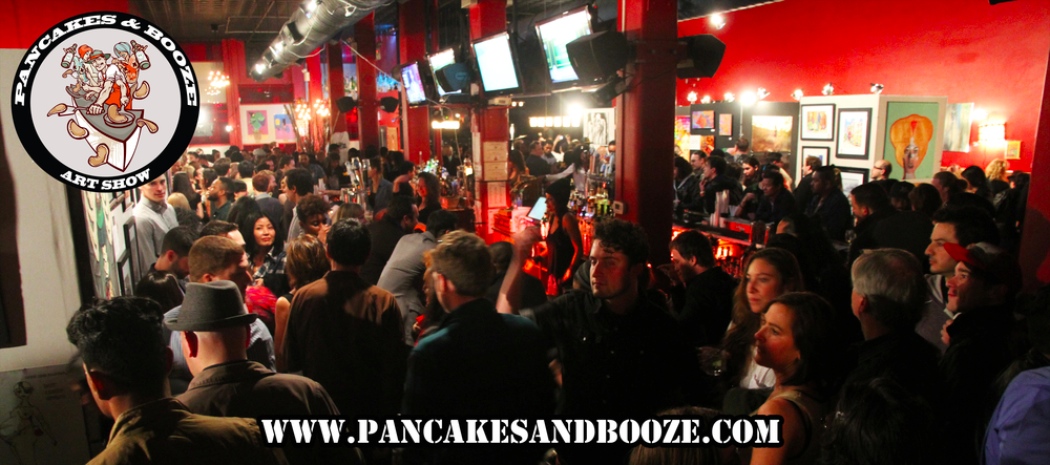
We will have a number of live artists creating work during the event. We open the floor up to anyone who wants to create a live art piece or do body painting for the show. Please just bring your supplies, along with a drop cloth, and do your thing. There is no need to sign up. All materials must be odour free.
Submit your application and we will get back to you as soon as possible
Most of the sales go through the artist. We highly recommend that everyone gets a credit card swiper for their phone. SquareUp and PayPal both are good options. We do not take credit cards so having your own system in place is key for making sales.
If you’re not around, we will make a sale in your absence and give you cash at the end of the night. As noted above, we do not take credit cards/checks/debit cards. If we act on your behalf during a transaction it will be cash only. We take NO COMMISSION ON SALES and will give you 100% of the cash sale at the end of the event.
After the transaction is made the buyer is allowed to take the work home with them on the spot. It is wise for you to have an extra piece on hand because you’re welcome to hang a replacement piece of equal or lesser size in the place of your sold piece. There is no extra fee for this.
You’re welcome to bring a small bin/tote/bag/etc to sell prints out of. Sorry, but we do not allow artists to set up tables to sell prints from.
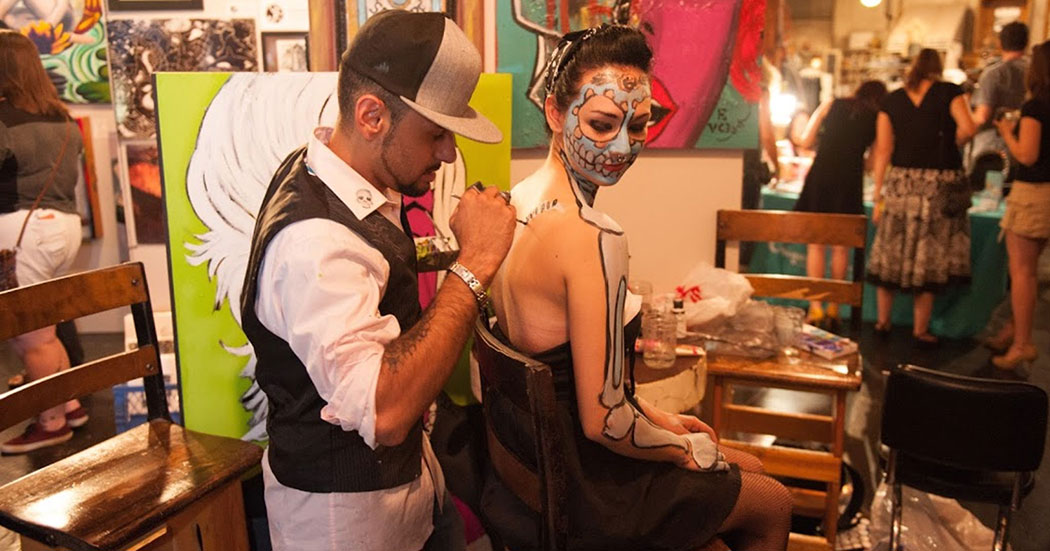
WHAT – The Pancakes & Booze Pop Up Art Show
WHERE – Studio Spaces E1
WHEN – 24th September 2015
[contact-form-7 id=”11271″ title=”Pancake & Booze”]
Site: www.pancakesandbooze.com
Twitter: www.twitter.com/pancakesbooze
Facebook: www.facebook.com/PancakesandBoozeArtShow
Instagram: www.instagram.com/pancakesandbooze/
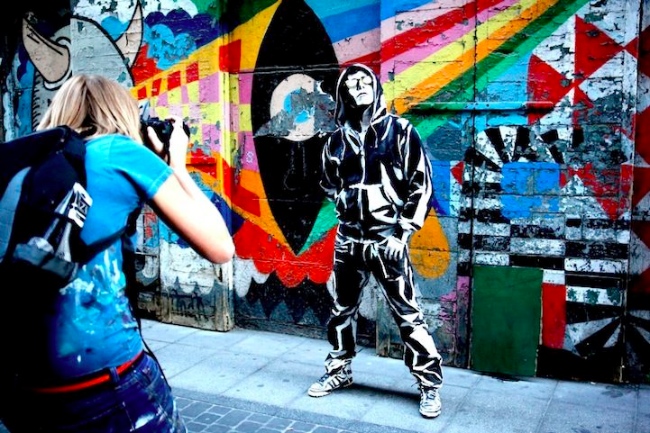 Meet Alexa Meade. He creates amazing series of living graffiti art but the twist is that he masters the ability of using actual people made to look like they belong in their 2D graffiti background.
Meet Alexa Meade. He creates amazing series of living graffiti art but the twist is that he masters the ability of using actual people made to look like they belong in their 2D graffiti background.
No need to say that the level of careful painting and attention to detail is huge here but it works pretty awesomely to turns three dimensional figures into two dimensional figures. All participants are painted in black and white and cleverly get tangled in the explosive and coloured backgrounds and the illusion of they are part of the static art is achieved.
You will see a few examples of Alexa Meade below.
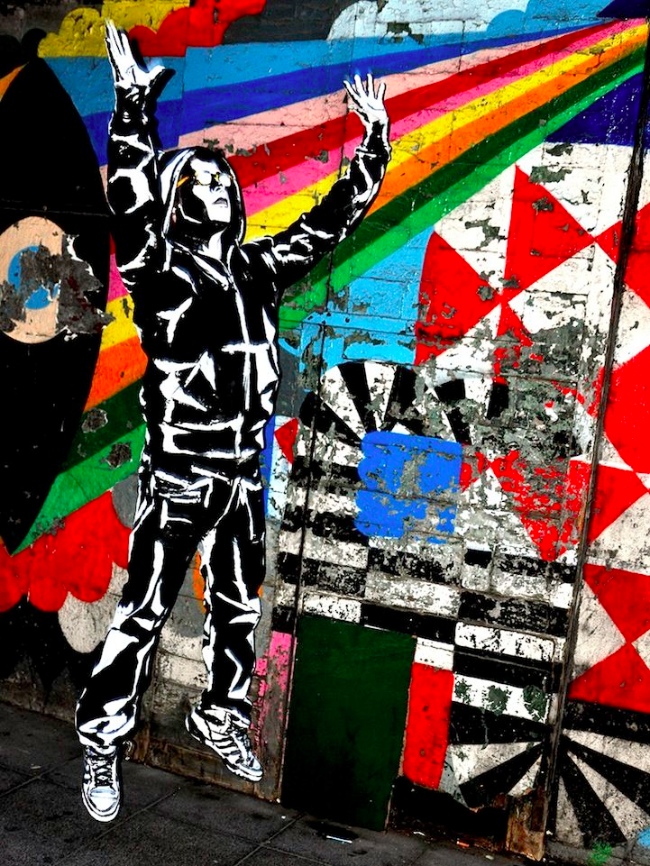
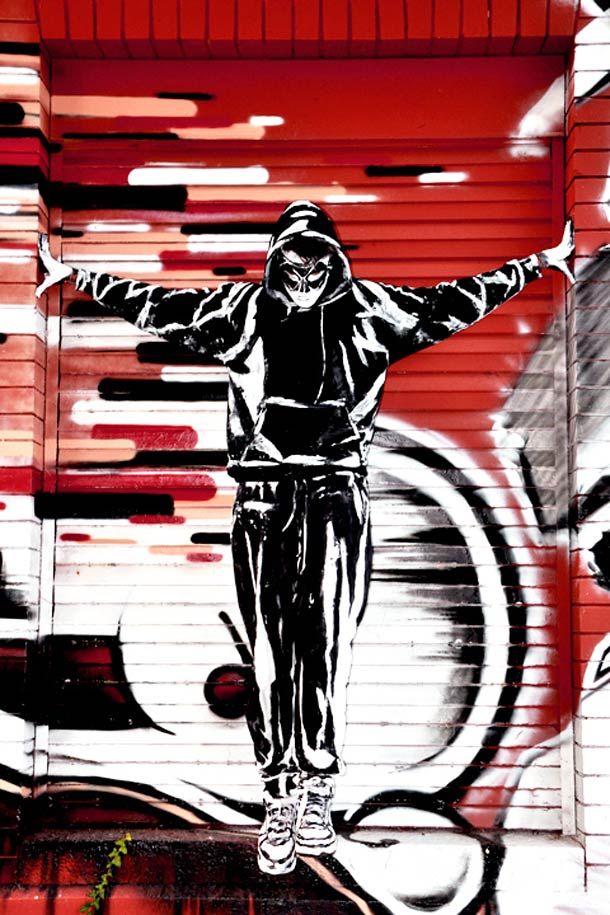
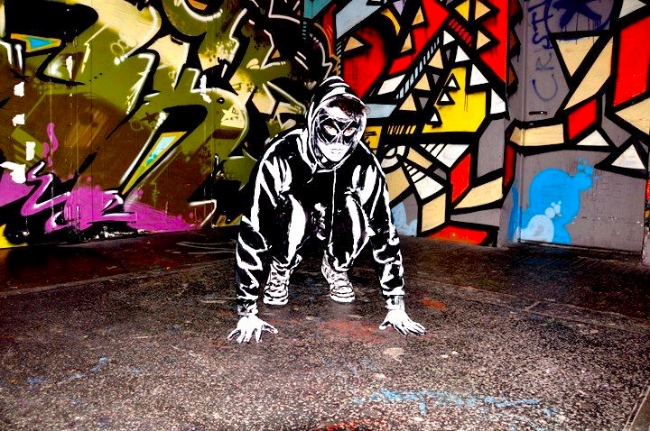
Wow, it really feels like we have been going on about Barcelona forever, not only it one of our favorite places to visit, yet there is always some much content to gather.
Fasim is some what of a local legend, being active on the local and global street scene for over 12 years. This show focussed on a more contemporary style. If this show was placed in any other gallery you would be hard pressed to find any link to a self taught graffiti artist, something we found very interesting.
This show was not so much about subject matter and more about the exploration of texture, with the use of heavy layering and scored paint to create depth. you really needed to view the works from all angels to get a complete feel for what Fasim was attempting to create.
This show was a easy on the eyes and set in a simple and welcoming gallery.
View the full set of shots here: http://www.flickr.com/photos/chasingghosts/sets/72157626702607658/
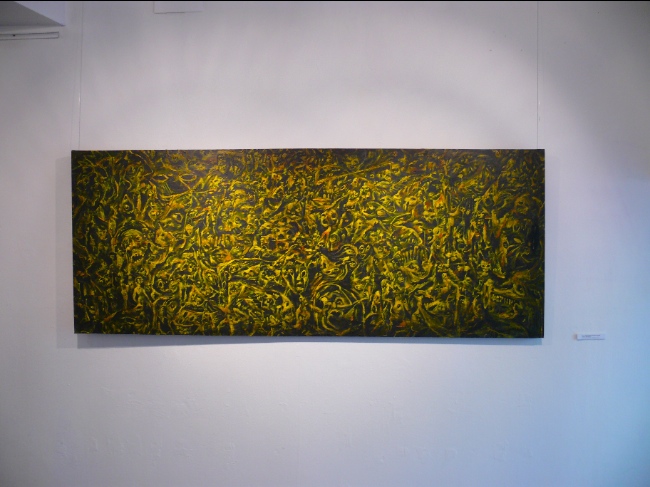
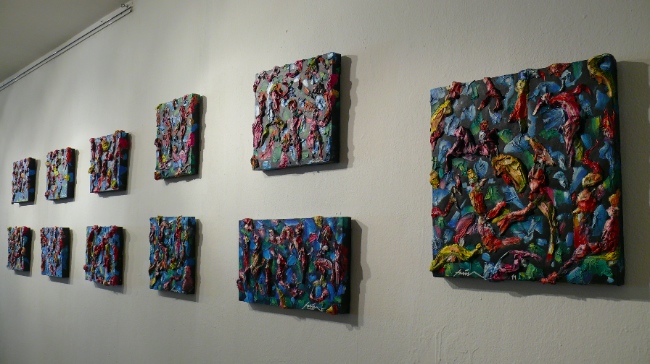
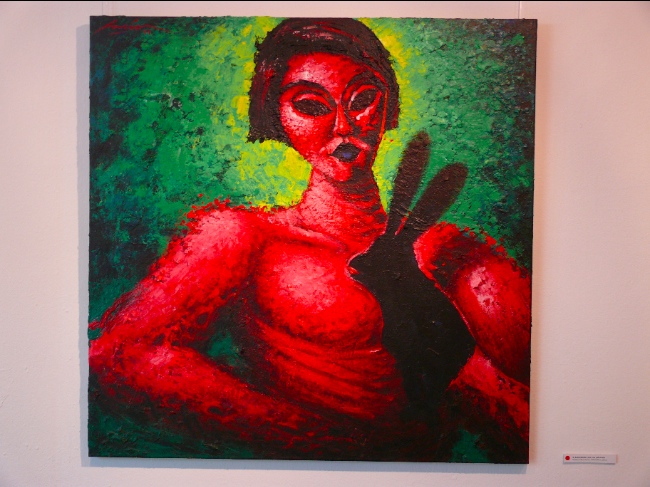
Gaston Gouron is a visual media artist based in Brussels. His work caught my attention at a show about art books. Not by surprise, yet I think more by design, I had picked out each of Gaston’s three artworks on display before swooping in to catch a word with him. I arranged to meet two days later in Bar De Matin – BDM to those in the know – a chatty bar in Place Eugéne. I went in with having noted down a few choice questions and also the book ‘The Secret War between Downloading and Uploading’. I’d intended this as a visual prompt to get us going on a Sunday morning. Luckily too we’re both keen on our coffee! Gaston launched in by telling me that notorious mega-uploads site had just been killed-off by the US government’s new anti-piracy laws.
‘Tutt!!’ He mentioned also the group called Script-Kiddies who work anonymously, and how he was fond of subverting the hacking potential of freewares like Keylogger to the advantage of as a tool for making artwork. He also threw in the word Caviarder – but not to be cast aside, really that word defines Gaston Gouron’s working process – which for him is to make things in a simple way or with no design.
Maybe this makes him a censor of what he considers to be an over-design of things? I asked him how much he thought his work to take refuge in and show hallmarks of the graffiti artist – expressive, edgy, playful? Here is the interview.
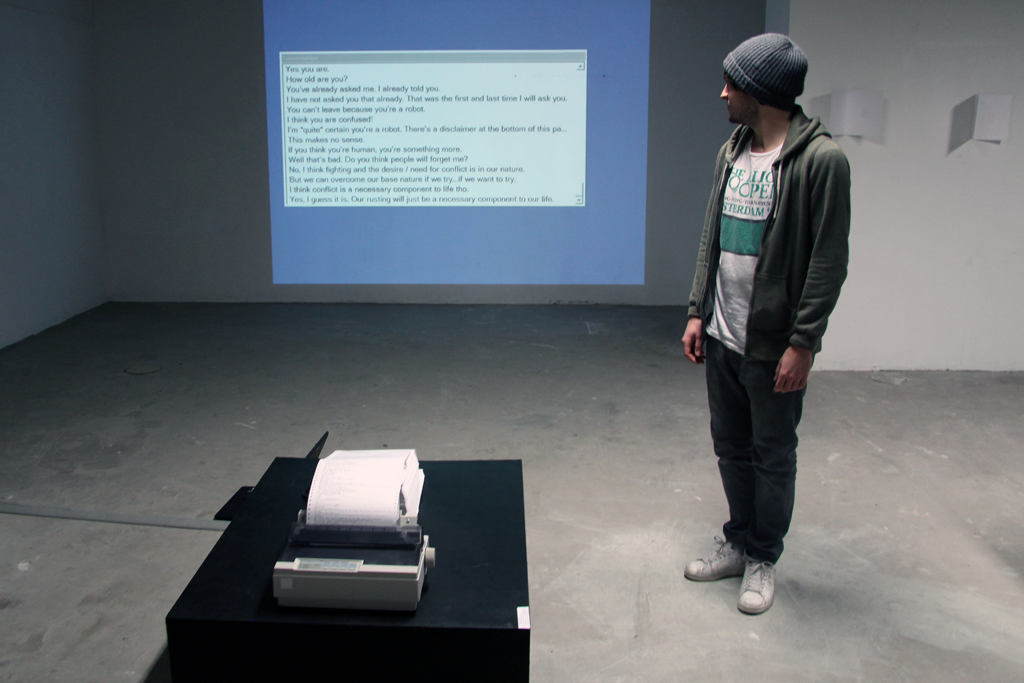
PW: Please describe your working method relating to the artwork Never-ending Conversation, exhibited in 50 Livres d’ Artistes at ARA (Amis de la Reliure d’Art) Belgica in January.
GG: It’s totally process driven, and it’s about finding a moment when something flips into being interesting, no; in fact, amazing. I do this on the web, chasing links that may have been sparked by a conversations with friends or a hangover from a previous idea.
Never-ending Conversation comes off the back of me buzzing around the internet and settling on something amazing. An example is when I discovered Chatbot, a web-based AI that you can talk with. I like to have fun with things so I was cutting & pasting text between the two conversation boxes to see how absurd it could be. But instead, Chatbot was sufficiently intelligent enough and made responses to expressions how you’d expect a human conversation to go.
That conversation became the default material I wanted to work with for one of my projects. As a bee might extract and pollinate, I wanted to do the same. Taking from one place and have it settle in another. Pollinating might be stretching the bee analogy too far though. It’s not that serious, really I’m simply interested in making things feel new.
PW: The artwork which you called Never-ending Conversation is very sculptural and invades the exhibition space but also plays with text that came literally out of thin air (or more aptly, it came virtually from the chatbot’s AI). So, how do you deal with the ‘real’ and ‘virtual’ and did that affect the way you chose to exhibit the artwork at 50 Livres d’Artistes?
GG: On the one hand I’m not proud to see the work presented. In reality it should appear more disordered. I created the original version in my bedroom which is more a workspace. I’m a collector too, collecting documentation about programming language and old network cables.
In a more common workspace environment Never-ending Conversation looks more ‘gutsy’ – how you’d expect a living machine should be. But when I saw it set-up in the exhibition space it looked, well… Naked! but I understand that the conditions – or restrictions – between workspace and exhibition space are very different.
In the stark, brightly lit – and clean! – exhibition space of ARA (a space with an orthodox for presenting aesthetically-biased artbook artists) I imagine my work is more readable to an audience. But It would be a great idea to have the work redone – simply to make the sprawling technology in the sculpture more obvious, revealing more about how it was put together. I’m really aware that I don’t want to conceal any part of the process.
PW: Which technological forms tend to produce the best renditions of language or ‘text-sampling’ that you’ve seen recently?
GG: Basic plain text.
I prefer reading rather than to listen to spoken words.
I just love data.
It’s strange I know, but more recently I’ve been understanding why my work borders on being seen as simplistic – which is a good thing. One thing is knowing about a study a friend sent to me. It shows that we read in contours – going from the corner of a page to the centre. So I think I’m interested in written material. Then I think about if it should be offered up as a bound-book, a pamphlet, a techno-language-sculpture. These are vessels and simply carry the language, I’m not even sure they’re that an important part of the process. The finding and discovering is more what I’m into.
PW: What’s interesting or peculiar that you’ve discovered about the ins and outs of language when you’re thinking how it needs to appear in or affect a piece of work?
GG: It’s that English language is most important in the creation process. It’s the language of IT and because I’m working a lot with script languages, English is most widely used. My mother tongue is French, but it’s not the language of IT and because I’m into revealing all of the process I’m always going to be showing parts of script and programming language.
One other thing is that using the French language this might make my work appear to be more exotic and specialist. It’s the opposite – I want to hit on an international crowd with an equally international language and for them to read the words. If they admire the vessel in which it’s concealed, then great, but for me it’s about getting the language to speak for itself.
PW: Who has done the most, or been most instinctive, in making the printed word part of their bank of visual language?
GG: I have several references. I would say the graphic works of Marcel Broadthaer’s and he’s Belgian. Japanese artist On Kawara is a big inspiration. He made two books retracing one million years – making the words and numbers from the dates into material – which then could be bound in a book, spoken out aloud and painted on a canvas (then, showing me on the screen of his laptop) like this.
http://metropolism.com/features/on-kawara-at-the-stedelijk-museu/english
I also can’t forget North Amercian artist Ed Ruscha for his famous graphics and text paintings. In England there’s Daniel Eatock – I love his work; well more than love. It’s his approach – easy and efficient. Then there’s Vaska who is Eatock’s founding partner of the web-building-platform Indexhibit. He came into my school last year. Working together they made the most clean of interfaces.
PW: ‘Artbook’ as a category seems an anathema to your visual language because you’re looking for ways of re-doing and re-showing printed texts. I can see a binary to the way you bulk-up on language and downplay the format (or vessel as you refer).
You serve-up things leaving the text in it’s raw elemental form – to fend for itself. So, how do you think your work relates to the ready-made, or made-ready?
GG: I produced Never-ending Conversation on a course I was studying at Lacambre Artes Visuels in Brussels. It was only 3 months and the course was refreshing because of the trans-disciplinary interests of the students I was studying with. Everyone doing this short-course was coming from a bigger discipline including design, photography, typography, urban space and for me it’s graphic communication. A bias is coming in too from a fine-art background but I’m also a programmer.
The tutors were really supportive an encouraged us to explore ideas. It’s completely energizing to share ideas with such a diversity of artistic personalities.
My work relates to the ready-made in process really. I do things to get rid of some idea – maybe to bank them so I can buzz on the next amazing discovery.
PW: We could go on, but thanks Gaston for the giving a nice twist to thinking about the how artbooks can still be brought to life beyond the printed and bound page.
GG: That’s OK
Gaston Gouron is currently writing his transcript for application to RCA, London.
Related: From 26 January to 6 May 2012 MAMbo – Museo d’Arte Moderna di Bologna is delighted to present Marcel Broodthaers. L’espace de l’écriture, the first complete retrospective in Italy devoted to the Belgian artist, curated by Gloria Moure.
Another show that was one not to miss so I pressed on to get there asap. Joram Roukes is a regular at Signal gallery, this is not his first show in the premises – Find out more
As soon as you step in, you cannot get your eyes off the large canvases that run along the walls. Joram Roukes mainly paints on a large scale with his preferred medium : oil once again. He clearly masters it and give us another set of figurative paintings where humans, animals and objects assemble.
As always, the artist’s work composition is simple: characters or simply a face on a plain background which emphasizes the figurative work. Joram Roukes breaks down to the extreme the usual sight we may be used to normalize when it comes to people’s apperances. You find yourself spending some time on each artwork, there is so much going on the canvas. Look closer and paintings within the painting shows up – see an example below.
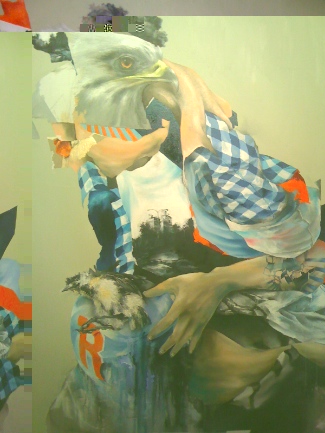
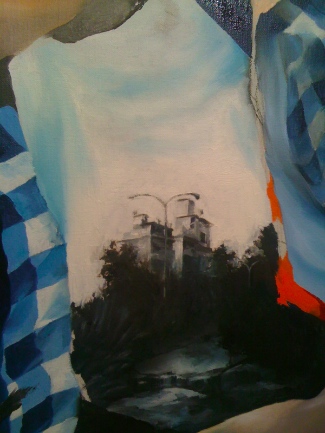
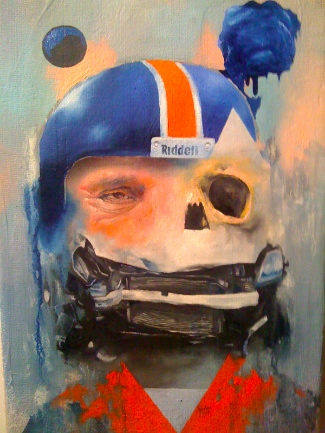
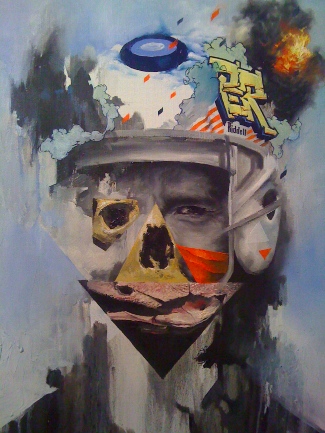
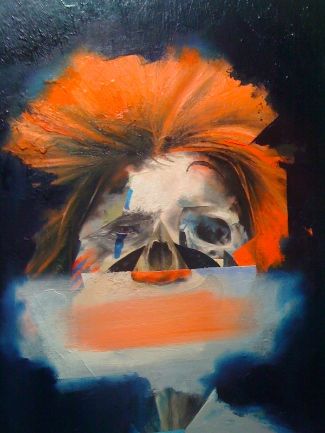
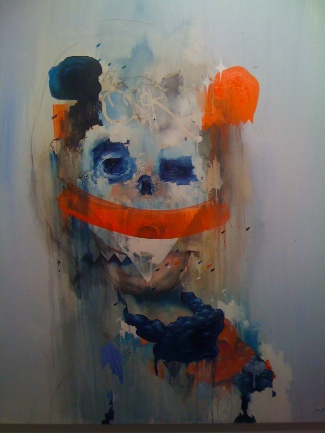
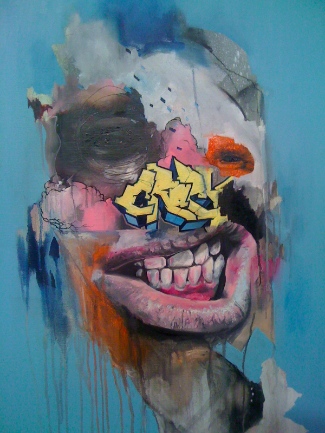
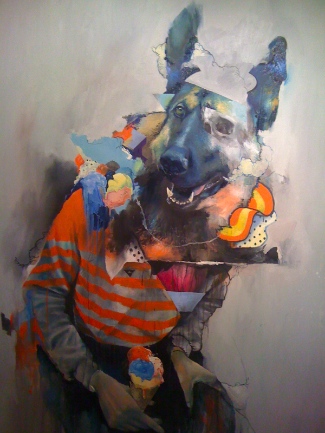
Part of our 3 street art works series you should see today. Artists featured are Benjamin Lozniger, El Mac and ?? (can you help?)
Benjamin Lozniger

El Mac
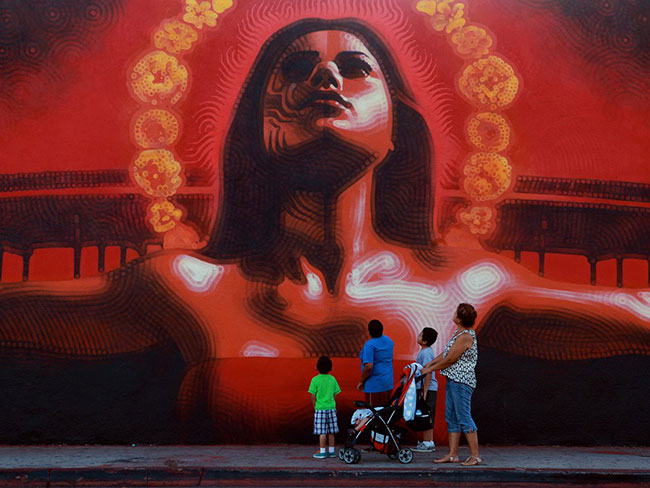
?? – can you help
